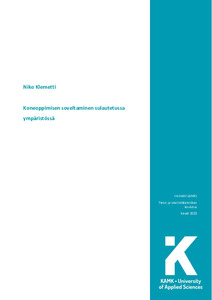Koneoppimisen soveltaminen sulautetussa ympäristössä
Klemetti, Niko (2023)
Klemetti, Niko
2023
All rights reserved. This publication is copyrighted. You may download, display and print it for Your own personal use. Commercial use is prohibited.
Julkaisun pysyvä osoite on
https://urn.fi/URN:NBN:fi:amk-2023060217427
https://urn.fi/URN:NBN:fi:amk-2023060217427
Tiivistelmä
Opinnäytetyön tavotteena oli tutkia, miten koneoppimista voidaan toteuttaa sulautetussa ympäristössä. Opinnäytetyö aloitettiin tutustumalla tekoälyn historiaan 1900- ja 2000-luvulla. Sen jälkeen perehdyttiin datatieteeseen ja sen osa-alueisiin, tekoälyyn, koneoppimiseen ja syväoppimiseen.
Tekoälyn historian ja datatieteiden yleiskatsauksen jälkeen painopiste siirrettin koneoppimiseen ja sen toteutukseen sulauteetussa ympäristössä. Lisäksi puhuttiin sulautetusta tekoälystä ja tutkittiin takoälymallin optimointitapoja. Tämän jälkeen syvennyttiin TinyML:ään, yhteen sulautetun tekoälyn osa-alueeseen.
Työ huipentui esimerkkisovellukseen, jonka tarkoituksena oli harjoitella tietojen keräämistä, neuroverkon koulutusta sekä reaaliaikaista testausta. Lopputuloksena syntyi ääniohjattu kaukosäädin, joka kykeni vastaamaan äänikomentoihin. The goal of this thesis was to investigate how machine learning can be implemented in an embedded environment. The thesis began by getting to know the history of artificial intelligence in the 20th and 21st centuries. This was followed by getting familiar ourselves with data science and its sub-areas, artificial intelligence, machine learning and deep learning.
After an overview of the history of artificial intelligence and data science, the focus shifted to machine learning and its implementation in an embedded environment. In addition, embedded artificial intelligence was discussed, and ways of optimizing the artificial intelligence model was studied. After that, the work delved into TinyML, one of the areas of embedded artificial intelligence.
The work culminated in an example application the purpose of which was to practice data collection, neural network training, and real-time testing. The end result was a voice-controlled remote that could respond to voice commands.
Tekoälyn historian ja datatieteiden yleiskatsauksen jälkeen painopiste siirrettin koneoppimiseen ja sen toteutukseen sulauteetussa ympäristössä. Lisäksi puhuttiin sulautetusta tekoälystä ja tutkittiin takoälymallin optimointitapoja. Tämän jälkeen syvennyttiin TinyML:ään, yhteen sulautetun tekoälyn osa-alueeseen.
Työ huipentui esimerkkisovellukseen, jonka tarkoituksena oli harjoitella tietojen keräämistä, neuroverkon koulutusta sekä reaaliaikaista testausta. Lopputuloksena syntyi ääniohjattu kaukosäädin, joka kykeni vastaamaan äänikomentoihin.
After an overview of the history of artificial intelligence and data science, the focus shifted to machine learning and its implementation in an embedded environment. In addition, embedded artificial intelligence was discussed, and ways of optimizing the artificial intelligence model was studied. After that, the work delved into TinyML, one of the areas of embedded artificial intelligence.
The work culminated in an example application the purpose of which was to practice data collection, neural network training, and real-time testing. The end result was a voice-controlled remote that could respond to voice commands.
